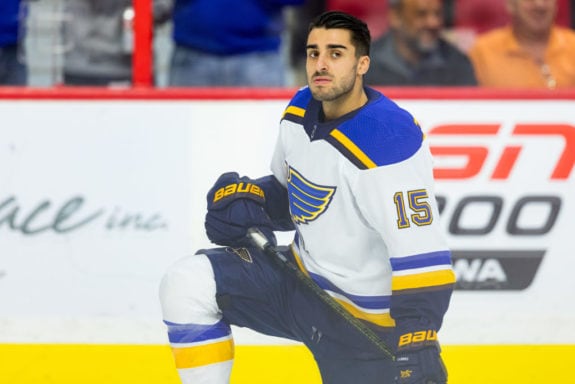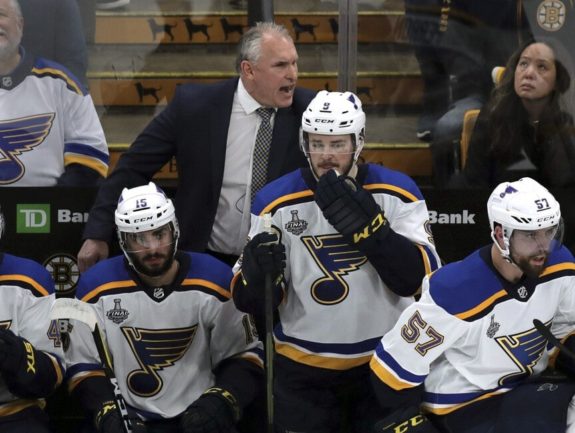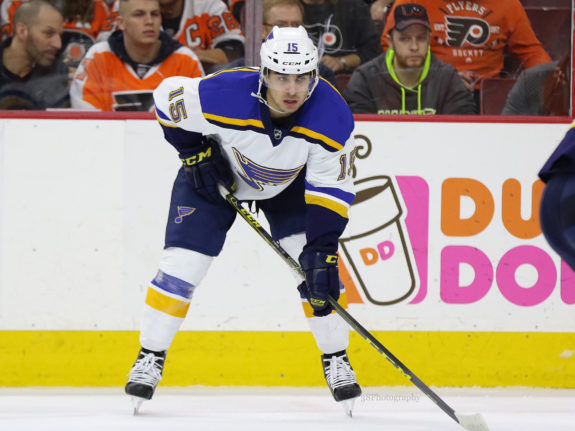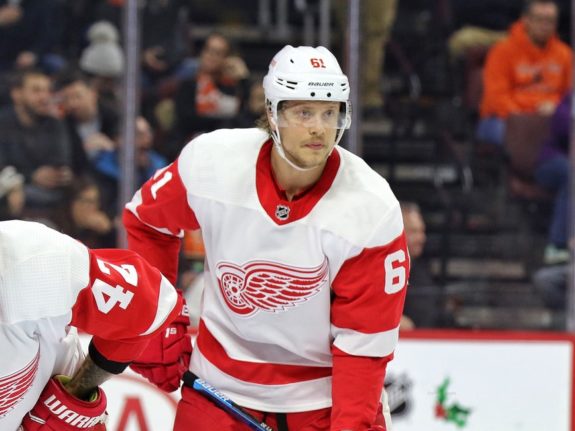Earlier this week, St. Louis Blues general manager Doug Armstrong made an unpopular move, parting with fan-favorite winger Robby Fabbri. In exchange, the Blues received Jacob de la Rose from the Detroit Red Wings, a return that underwhelmed many of Fabbri’s more ardent supporters.
The trade is not a clear “win” for the Blues on paper, particularly after Fabbri scored twice in his Detroit debut. But a closer investigation of the circumstances around the trade proves that it was a necessary evil for the team and that it was a move the organization needed to make.
Fabbri’s Long Road Back
The Blues drafted Fabbri with their first pick in the 2014 Draft. After a strong final season in juniors with the Guelph Storm (where he played along with new Red Wings teammate Tyler Bertuzzi), he debuted in the NHL at age 19 at the start of the 2015-16 season. He recorded 37 points in 72 games, and wowed fans during the playoffs, tying the team lead with 15 points in 20 games. Everything looked to be bright for his future, and he was a centerpiece of the Blues’ plans.

Unfortunately, that’s when his career turned. Fabbri suffered consecutive devastating knee injuries, first in the 2016-17 season, and then again during the following preseason. He twice required surgery on the same ACL, forcing him to miss an entire season and a half.
By the time he returned to the Blues roster in November 2018, Armstrong had totally transformed it. He’d brought in forwards like Ryan O’Reilly and Brayden Schenn, along with young players like Robert Thomas, and there wasn’t an obvious spot for Fabbri anymore. Compounding issues, the Blues replaced their head coach, Mike Yeo, with Craig Berube just a few weeks after Fabbri returned. He struggled to earn the respect of his new coach and ultimately played in just 32 games on the season.

The Blues went onto postseason glory, but Fabbri remained a bit player. He played in just 10 games, scoring one goal, and even though he lifted a Stanley Cup at the end of the season, it was clear that he was no longer a building block in Armstrong’s (or Berube’s) blueprint.
A Trade Request
In light of his position on the team, it’s understandable why Fabbri was unhappy. And since the trade, multiple outlets, including the St. Louis Post Dispatch and the Athletic, have reported that he requested a trade from Armstrong over the summer. The writing was on the wall: with an already loaded lineup, the emergence of fringe players like Samuel Blais and Zach Sanford during the playoffs, and the threat of prospects like Klim Kostin and Jordan Kyrou coming up and stealing time, Fabbri knew he’d have a difficult time finding playing time with the Blues.
For a player in his condition, it’s about more than pride: Fabbri is just 23, still a young player by anyone’s standards. But with the knee damage he suffered and the long rehabilitation he went through, he desperately needs playing time to prove that he’s the same player he used to be. That, coupled with the reality that multiple serious injuries usually shorten careers, made finding playing time even more pressing for Fabbri than it might be for other young players his age.

Fabbri patiently waited for Armstrong to find the proper partner, but his frustration began to show. According to The Athletic, he told their reporters that he was “tired of watching” back in training camp, and then, after he was scratched for the first time this season on Oct. 21, responded to questions by saying simply, “I just work here” (from ‘Robby Fabbri hoped for more opportunity, but holds no hard feelings after Blues deal him to Detroit,’ The Athletic, Nov. 7, 2019).
After the Blues scratched Fabbri for all but one of their next nine games, including both halves of a back-to-back that would culminate in his final game as a Blue, it became clear that the end of his time was approaching. Ultimately, the announcement came swiftly and unexpectedly in the immediate aftermath of a 5-2 win against the Edmonton Oilers: Fabbri was gone, not even mentioned by name in the Blues’ trade announcement tweet, and de la Rose was now a Blue.
What the Blues Get in de la Rose
De la Rose is in a difficult spot now, coming in replacing a fan favorite in a trade that was made more for emotional reasons than for team benefit. But that doesn’t mean he can’t prove valuable to the Blues.

De la Rose is a Swedish forward who plays primarily on the wing, though he can pivot to center on occasion. He shouldn’t need to with the Blues, as they have depth enough at that position. The Montreal Canadiens drafted him in 2013 with the 34th overall pick, and since then, the 24-year-old has played in 195 NHL games, scoring 12 goals and notching 20 assists in that time.
It’s clear from those numbers that de la Rose can’t be relied upon for the same production a healthy Fabbri would have. But that’s not what the Blues need from him. Berube was likely hoping for an additional defensively responsible forward for a fourth line and penalty-killing role, and de la Rose will provide that. Arpon Basu, a Montreal Canadiens writer for The Athletic, labeled him an “elite” backchecker after the trade.
At 6-foot-3, 215 pounds, de la Rose also brings size, something the Blues have lacked, particularly since hometown hero Patrick Maroon departed in the offseason. Berube, a grinder and fighter in his own career, no doubt values such size and defensive reliability in his lineup, so the fit, while perhaps not exciting for Blues fans, is an obvious one.
The Right Thing to Do
Fans will look at the point-potential disparity between Fabbri and de la Rose and criticize the return on this trade. But this trade really isn’t about the return, as much as any NHL can be about anything else.
Fabbri’s career had fallen on hard times, and the young player needed and desperately wanted a change of scenery. Armstrong, who usually treats his players well, acknowledged his desire and saw that it was a fair request, and ultimately when an acceptable offer came along, he pulled the trigger.
That may not make this a perfect trade for the Blues, and it may go down in history as one of the more lopsided loses in Armstrong’s tenure, if Fabbri returns to form. But Armstrong knows and accepts that risk. This is one of those rare instances where the team does the right thing for one of its players rather than serve its own best interest. It may seem like a loss in the short term, but it was a necessary evil to allow Fabbri the best opportunity to rehabilitate his career, and no one in St. Louis wants anything but the best for him in his future.